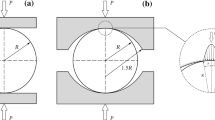Abstract
The validity and rationality of the Brazilian disc test have attracted much attention since it was proposed. To verify the validity of four Brazilian disc tests, red sandstone and yellow rust granite were employed. In these experiments, uniaxial tensile tests and four Brazilian disc tests were performed. Meanwhile, the typical location of the Brazilian discs was arranged with gages to detect the crack initiation location. By analyzing the rationality of the four Brazilian disc tests from two aspects, the crack initiation location and the difference between indirect tensile strength and direct tensile strength, it was found that the Brazilian disc tests without cushion and the Brazilian disc tests with two small-diameter steer rods are suitable for determining the indirect tensile strength of rock materials. However, the Brazilian disc tests with arc loading jaws should be carefully adopted to measure the indirect tensile strength due to their overestimation of the indirect tensile strength. Additionally, flattened Brazilian disc tests were found to be not suitable for measuring the indirect tensile strength of rock materials.




Similar content being viewed by others
References
Akazawa T (1943) New test method for evaluating internal stress due to compression of concrete: the splitting tension test. Jpn Soc Civ Eng 29:777–787
ASTM D 3967-08 (2008) Standard test method for splitting tensile strength of intact rock core specimens. ASTM International, West Conshohocken
Carneiro FLLB (1943) A new method to determine the tensile strength of concrete. In: Paper presented at the proceedings of the 5th meeting of the Brazilian Association for Technical Rules (“Associacao Brasileire de Normas Tecnica-ABNT”), 3d. Section
Chen S, Yue ZQ, Tham LG (2004) Digital image-based numerical modeling method for prediction of inhomogeneous rock failure. Int J Rock Mech Min 41(6):939–957
Colback PSB (1966) An analysis of brittle fracture initiation and propagation in the Brazilian test. In: Paper presented at the proceedings of the first congress international society of rock mechanics, Lisbon, Portugal
Efimov VP (2009) The rock strength in different tension conditions. J Min Sci 45(6):569–575
Erarslan N, Williams DJ (2012) Investigating the effect of cyclic loading on the indirect tensile strength of rocks. Rock Mech Rock Eng 49:21–30
Fairhurst C (1964) On the validity of the ‘Brazilian’ test for brittle materials. Int J Rock Mech Min 1(4):535–546
Hondros G (1959) The evaluation of Poisson’s ratio and the modulus of materials of a low tensile resistance by the Brazilian (indirect tensile) test with particular reference to concrete. Aus J Basic Appl Sci 10(3):243–268
Hooper JA (1971) The failure of glass cylinders in diametral compression. J Mech Phys Solids 19(4):179–200
Huang YG, Wang LG, Lu YL et al (2015) Semi-analytical and numerical studies on the flattened Brazilian splitting test used for measuring the indirect tensile strength of rocks. Rock Mech Rock Eng 48:1849–1866
Hudson JA, Brown ET, Rummel F (1972) The controlled failure of rock discs and rings loaded in diametral compression. Int J Rock Mech Min 9(2):241–248
ISRM (1978) Suggested methods for determining tensile strength of rock materials. Int J Rock Mech Min 15(3):99–103
Lavrov A, Vervoort A (2002) Theoretical treatment of tangential loading effects on the Brazilian test stress distribution. Int J Rock Mech Min 39(2):275–283
Li D, Wong LNY (2013) The Brazilian disc test for rock mechanics application: review and new insights. Rock Mech Rock Eng 46:269–287
Lin H, Xiong W, Xiong Z et al (2015) Three-dimensional effects in a flattened Brailian disk test. Int J Rock Mech Min 74:10–14
Lin H, Xiong W, Yan Q (2016) Modified formula for the tensile strength as obtained by the flattened Brazilian dist test. Rock Mech Rock Eng 49(4):1579–1586
Malan DF, Napier JAL, Watson BP (1994) Propagation of fractures from an interface in a Brazilian test specimen. Int J Rock Mech Min 31(6):581–596
Markides CF, Pazis DN, Kourkoulis SK (2011) Influence of friction on the stress field of the Brazilian tensile test. Rock Mech Rock Eng 44(1):113–119
Markides CF, Pazis DN, Kourkoulis SK (2012) The Brazilian disc under non-uniform distribution of radial pressure and friction. Int J Rock Mech Min 50(1):47–55
Pandey P, Singh DP (1986) Deformation of a rock in different tensile test. Eng Geol 22(3):281–292
Satoch Y (1987) Position and load of failure in Brazilian test a numerical analysis by Griffith criterion. J Soc Math Sci Jpn 36(410):1219–1224
Sundaram PN, Corrales JM (1980) Brazilian tensile strength of rocks with different elastic properties in tension and compression. Int J Rock Mech Min 17(2):131–133
Swab JJ, Yu J, Gamble R et al (2011) Analysis of the diametral compression method for determining the tensile strength of transparent magnesium aluminate spinel. Int J Fracture 172:187–192
Wang M, Cao P (2016) Numerical analysis of flattened Brazilian disc test based on the cusp catastrophe theory. Math Probl Eng 2016: 4517360
Wang QZ, Jia XM, Kou SQ et al (2004) The flattened Brazilian disc specimen used for testing elastic modulus, tensile strength and fracture toughness of brittle rock: analytical and numerical results. Int J Rock Mech Min 41(2):245–253
Yanagidani T, Sano O, Terada M et al (1978) The observation of cracks propagating in diametrically-compressed rock discs. Int J Rock Mech Min 15(5):225–235
Yu Y (2005) Questioning the validity of the Brazilian test for determining tensile strength of rocks. Chin J Rock Mech Eng 24(7):1150–1157 (in Chinese)
Acknowledgements
This study was funded by the Open Research Fund Program of Hunan Provincial Key Laboratory of Shale Gas Resource Utilization, the Hunan University of Science and Technology (Grant No. E21527), and the Fundamental Research Funds for the Central universities of Central South University (Grant No. 2015zzts077).
Author information
Authors and Affiliations
Corresponding author
Ethics declarations
Conflict of interest
The authors declare that there is no conflict of interests regarding the publication of this paper.
Rights and permissions
About this article
Cite this article
Wang, M., Cao, P. Experimental Study on the Validity and Rationality of Four Brazilian Disc Tests. Geotech Geol Eng 36, 63–76 (2018). https://doi.org/10.1007/s10706-017-0302-0
Received:
Accepted:
Published:
Issue Date:
DOI: https://doi.org/10.1007/s10706-017-0302-0




